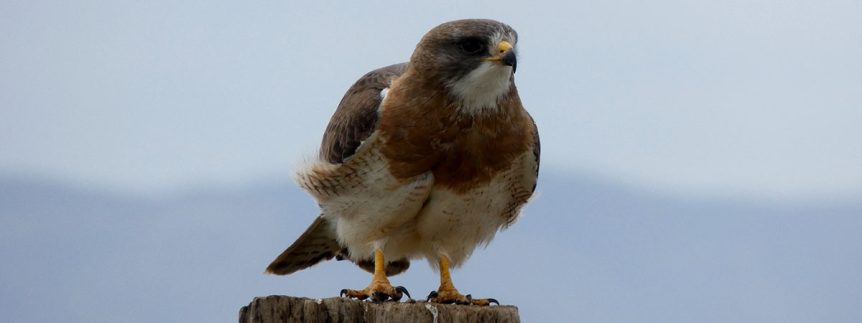Read the Transcript
This year, 2016, marks the centennial of the first Migratory Bird Treaty, which the United States signed with Great Britain on behalf of Canada. That treaty and the three that followed — with Japan, Russia and Mexico — form the cornerstones of our efforts to conserve migratory birds, like the Swainson’s Hawk.
Swainson’s Hawk is a commuter. It has one of the longest migrations of any American raptor. They winter in Argentina, then fly into North America as far as Canada to nest and breed during our summer. The bird can make the 6,200 mile trip in less than two months, averaging nearly 124 miles a day. And these birds get very hungry along the way, according to Matt Bain with The Nature Conservancy’s Smoky Valley Ranch in western Kansas.
“When Swainson’s Hawks are migrating, they are highly insectivorous. They really depend on things like grasshoppers. So, they are going to be foraging in some of those lower vegetation areas that have a high density of insects.”
When it’s time to nest and mate, their diet changes.
“They’re utilizing rodents, prairie dogs and other mammal species.”
So this bird’s diet consists of critters considered pests by crop producers. Professor Clint Boal, at Texas Tech University at Lubbock, has studied this bird in the Texas panhandle.
“Swainson’s and Ferruginous, in particular, are wide-open country grassland raptors — and a lot of this area has undergone development.”
Agricultural development converted a lot of prairie into cropland. Boal says a lot of landowners he encountered were very concerned that Swainson’s Hawks were preying on game birds, or other valued species.
“In other areas, they’re known to forage around alfalfa fields, for example, and crop fields. They prey a lot on ground squirrels. So, they’re a fairly valuable raptor around agricultural interests.”
Many grassland birds are ground nesters and stay away from vertical structures that might harbor raptors. The Swainson’s Hawk does nest in trees and tall structures — trees planted for windbreaks.
“That’s really provided nesting habitat for Swainson’s Hawks. By putting up some wind breaks and occasional shade trees, the hawks readily use those. Now, they don’t like to nest near a house or a barn where there’s a lot of human activity, but a lot of these old houses or barns that have been abandoned, or barns that are only used occasionally… if there’s some trees around there, a lot of times you’ll find Swainson’s Hawks nesting there.”
Early naturalists who wandered the prairies of the West observed this bird in great abundance. Then, says Clint Boal, things changed.
“As the landscape was settled, numbers appeared to decrease substantially. In the 1980s, there was increasing concern for Swainson’s Hawks in a lot of areas — primarily driven by habitat loss.”
But now, the hawk’s population seems stable, and maybe even increasing in some areas.
“The main thing, I think that we need to be aware of for conservation of this species, is the issue of habitat loss, which is where the Farm Bill and conservation programs really come in. They need to have wide-open grassland country to forage in. If they don’t have areas to forage in, they’re not going to persist.”
Boal says in places there’s still a mentality that the only good hawk is a dead hawk, and that’s short-sighted.
“All of these raptors, they have important functions in their ecosystems. And they are primarily preying on animals that most landowners would find to be pests.”
Playa Country, which ended in late 2016, was a weekly show that featured conservation and wildlife experts — as well as farmers, ranchers and land managers — talking about conservation practices that improve wildlife habitat and landowners’ bottom-line. Our thanks to Cornell Lab of Ornithology’s Macaulay Library, in Ithaca New York, for the featured bird song.

